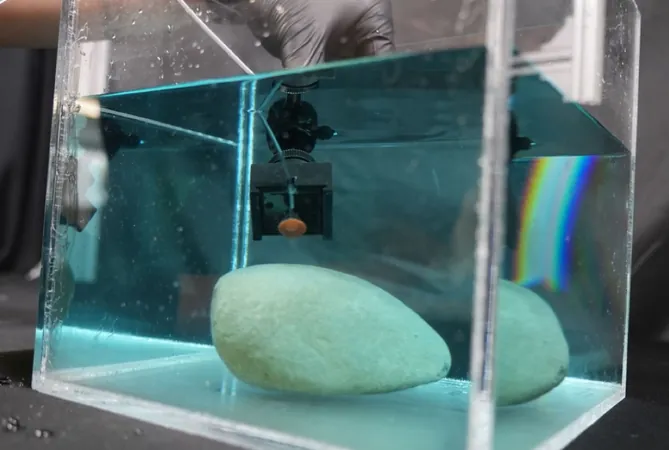
Harnessing the Power of Octopus Suckers: Revolutionary Underwater Grip Technology Unveiled!
2024-10-09
Author: Wei
Introduction
Recent advancements by scientists at Virginia Tech are taking cues from the incredible octopus to develop groundbreaking underwater gripping technologies. In a fascinating new paper published in *Advanced Science*, researchers have introduced a unique switchable adhesive inspired by the shape and function of octopus suckers, demonstrating potential game-changing applications in underwater exploration and robotics.
Octopus Inspiration
Lead researcher Michael Bartlett expressed his fascination with the octopus's ability to finely control its grip, saying, "An octopus can hold tightly onto various surfaces—whether rough, curved, or irregular—and release at a moment's notice. This remarkable adaptability is what we're striving to replicate." The team believes that emulating this natural skill paves the way for more precise manipulation of objects in aquatic environments.
Comparison with Other Species
Nature has given us other examples of remarkable adhesion techniques—mussels secure themselves with sticky proteins and frogs use specialized toe pads—but octopuses stand out for their ability to quickly adjust their grip. This versatility allows them to cling to both wet and dry surfaces, making them highly efficient in their underwater habitats.
Engineering Insights
From an engineering standpoint, the secret lies in the octopus's pressure-driven adhesion system, which involves creating a vacuum seal with the object's surface. The outer rim of the sucker generates a pressure difference, allowing for a secure grip. While previous attempts to mimic octopuses in robotic designs have been made, Bartlett and his team took it a step further in 2022 with the development of the Octa-Glove—a wearable device designed to replicate octopus-like gripping capabilities.
The Octa-Glove
The Octa-Glove features silicon stalks capped with pneumatic membranes, akin to octopus suckers. Integrating LIDAR sensors provides real-time detection of objects, enabling the glove to engage its grip much like an octopus’s nervous system. Built on a neoprene glove, it includes these adhesion technologies in each finger, and pneumatic tubes facilitate the switching mechanism between grip and release.
Design Improvements
In this latest round of research, the team improved the design of the Octa-Glove by incorporating curved silicone stalks that mimic the biological functionality of octopus suckers, enabling them to deform and adhere to a variety of surfaces. The switching between grip and release is remarkably rapid—occurring within just 30 milliseconds—making this technology up to 1,000 times stronger when activated.
Testing and Results
Testing protocols involved deploying individual adhesives and arrays of five, with results showing a linear increase in attachment force without compromising stability. The team successfully tested their adhesive technology on various shapes and surfaces, including rocks and delicate hydrogel balls.
Demonstration and Applications
To demonstrate their invention further, researchers built an underwater cairn—an arrangement of stones of varying sizes and textures—taking inspiration from how octopuses organize objects in their dens. Intriguingly, the adhesives maintained functionality after enduring multiple attachment cycles, demonstrating the ability to hold objects for over a week before release, showcasing tremendous potential for underwater salvage and rescue missions.
Future Directions
As this research highlights, understanding the underlying geometry of contact points is essential for future developments in synthetic underwater adhesives. By exploring variations in stalk architecture and membrane designs, researchers hope to fine-tune these innovative systems for even greater control of underwater attachment and manipulation.
Conclusion
In sum, the Virginia Tech team's work is not just a mechanical marvel; it emphasizes the potential of biomimicry in engineering, promising enhanced performance for underwater applications that may soon be utilized in various fields, from marine biology research to potentially life-saving rescue operations. Exciting times are ahead as we stand on the brink of a new era in underwater technology!


 Brasil (PT)
Brasil (PT)
 Canada (EN)
Canada (EN)
 Chile (ES)
Chile (ES)
 España (ES)
España (ES)
 France (FR)
France (FR)
 Hong Kong (EN)
Hong Kong (EN)
 Italia (IT)
Italia (IT)
 日本 (JA)
日本 (JA)
 Magyarország (HU)
Magyarország (HU)
 Norge (NO)
Norge (NO)
 Polska (PL)
Polska (PL)
 Schweiz (DE)
Schweiz (DE)
 Singapore (EN)
Singapore (EN)
 Sverige (SV)
Sverige (SV)
 Suomi (FI)
Suomi (FI)
 Türkiye (TR)
Türkiye (TR)